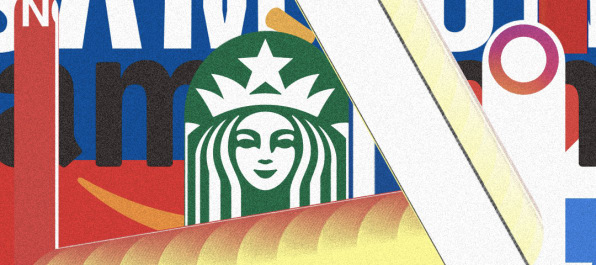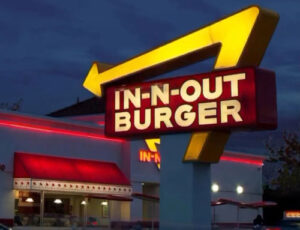10 Rules for Building a Powerful Brand
Building a powerful brand doesn’t just mean excellent graphic design or adopting a trendy one-syllable name like Bread or Primer.
In fact, here’s a name generation tool where you can come up with all sorts of trendy startup names.
Those may turn out to be the right decisions, but in order to build a powerful brand, you have to unpack the needs of your audience and your market first – then align those with the direction of your organization.
If you gather the right inputs and find the right partner to translate them into informed creative choices, you can align an organization around a powerful brand that becomes its own asset, increasing in value over time.
Powerful brands help with:
- Attracting and retaining top talent
- Maintaining and growing customer relationships through loyalty
- Multiplying the impact of marketing & sales efforts
- Driving organization-wide decision-making
Here are 10 rules to keep in mind when you’re aiming to build a powerful, lasting brand that fuels your organization and resonates with your target audiences.
Table of Contents:
1. Brand is far more than a logo.
2. Brand is the entire set of experiences & expectations that you have of an organization.
3. Every company, organization, or group of people has a brand.
5. Research-informed brand strategy is a powerful tool for making leadership decisions.
7. “Re-brand” is a strange term.
9. Telling is great. Showing is better.
10. Great brands drive organization objectives.
1. Brand is far more than a logo.
A lot of organizations focus on the logo as THE focal point for their brand; the epicenter where all other brand attributes and aspects stem from.
The logic goes something like this: If we change the logo, we change the brand.

While the logo is a key part of any brand, it’s not a great summation of a ‘brand’. A graphic made of abstract shapes, colors, and potentially some words should be a clear brand expression, but it’s not always the best way to articulate core attributes across an organization and an audience.
For an example, consider Jon Hollamby’s 2018 article in Fast Company titled No One Cares About Your Logo
Jon Hollamby is the Creative Director at the Australian property app Domain (you can reach him on Twitter @jonhollamby or LinkedIn), and we’ve pulled out sections of his article below with our Creative Lead Mark Rantal’s thoughts throughout to help articulate where exactly a logo fits in the grand scheme of a brand.
Jon Hollamby: Somehow companies have gotten into the mindset that a logo – this thing that does nothing more than identify us – is incredibly important.
But logos on their own actually say nothing. While they can make people aware of your brand and help with discovery and recognition, they can’t tell your customers who you really are, or what you actually care about unless you build meaning into them.
Mark Rantal: I disagree that logos say nothing. Jon says that a logo can’t tell your customers who you really are, but I think a more honest phrase would be that a logo can’t convince your customer who you really are. Visual choices still do make a difference. There’s a reason that the Dallas Cowboys are silver and blue, and not pink and turquoise. There’s a reason Tesla can’t use Comic Sans and a reason that Build-A-Bear Workshop can.

Jon Hollamby: Your logo is not your brand. Your brand is the experience your customers have and then tell their friends about. All the design craft in the world can’t make a logo that can convince someone your product or service is great if it isn’t. That’s a job for advertising.
Don’t get me wrong: We still need logos, but it’s nonsense to make a logo the foundation of your brand.
Mark Rantal: I agree – logos are not foundations. Your visual look is more like clothing, while Jon’s article is a conversation about personality. As a brand, your clothes do matter, but aren’t the whole picture.
The title should be ‘No one cares about your well-tailored suit’. Of course, someone does care, but to make the suit the foundation of a personality would be as backwards as making a logo the foundation of a brand. And this is the quiet truth behind Jon’s hyperbolic criticism of logo designers.
Jon Hollamby: So let’s take some pressure off them, they really don’t need to work so hard. They can put their feet up for a while, while we dig into what makes for a great brand.
Mark Rantal: Still valid.

Jon Hollamby: Great brands are built from the inside out; they are built around a strong belief system and are driven by values. What your customers experience every time they interact with your company is the brand, not the visual identity. No one cares that your airline logo has been crafted out of unicorn tears and your visual language is AI-generated if their flight keeps getting canceled or they get involuntarily de-boarded because you overbooked the flight.
Mark Rantal: This is something I hear across all levels of Magneti – how you behave as an organization is more and more important. In this bygone era of Mad Men advertising tactics, you can’t hide behind a logo, an ad or a flashy corporate lobby. Modern companies now have to interact in an online space and be more open, vulnerable and transparent about their goals.
This is why Jon is right – focusing on your experiential brand before your visual brand is the right way of producing something cohesive.
Jon Hollamby: So instead of fretting over typefaces and clever negative space logo executions, ask yourself this one question: “Why do I get out of bed every morning and go to work?”
That’s what your brand should be built around. That is what you want your customers to remember and tell their friends about; not your logo.
Take a quick look at Nike. Phil Knight had a vision that if everyone went for a run once a day, the world would be a better place. He believed in that vision so much that he only hired people who shared it. Why? Because if you have a purpose that people can believe in, then you have a product that the people building the brand will advocate for, and you can bet they’ll do a good job of it. The swoosh is just a swoosh; any emotional connection you have to it has nothing to do with the logo itself and everything to do with Knight’s original vision.
 Mark Rantal: Nike’s experiential brand of believing in the power of fitness is what people relate to. But to say that the swoosh is just a swoosh – I wonder if the logo would be as effective as a red octagon. Logos should feel like they grew out of an experiential brand. Not be the foundation.
Mark Rantal: Nike’s experiential brand of believing in the power of fitness is what people relate to. But to say that the swoosh is just a swoosh – I wonder if the logo would be as effective as a red octagon. Logos should feel like they grew out of an experiential brand. Not be the foundation.
As a designer, it would be amazing if everyone got excited about kerning, color tetrads, and stroke weight. If you do want to make big organizational goals, talk about goals, talking about purpose – these things can excite your workers and audience much more than explaining why a modern sans serif truly captures a hip modern persona.
Jon Hollamby: The bottom line is, customer experience is more than the product or service and more than the brand. It is every single interaction and touchpoint people have with you, from the person in the call center to the app error message they receive.
I appreciate a well-crafted logo as much as the next person–I just don’t believe it’s that important anymore. I have come to believe in the power of a brand that is built on really solid experiential foundations, not just graphic design.
Remove your logo from your product, your website, your app, and your ads, and your customers should still know it’s you. Give your logo a break and focus on delivering a great customer experience–that’s what will turn your customers into advocates.
Mark Rantal: Feel free to be excited about your logo. Feel free to get someone who has cared about logos since third grade to make one for you. A logo designer’s craft will help your personas shine more accurately. Jon’s wrong. Some of us really care about your logo. But Jon’s right. People care about what you’re doing more.
Don’t get caught up handing out bits of swag with a new logo on them. Or you run the risk of mistaking the flag for the revolution.
All imagery and text are property of their respective owners.
2. Brand is the entire set of experiences & expectations that you have of an organization.
This is where we put a stake in the ground and define our terms.
What is a brand?
Brand is defined as the perceptions that you own. These ‘perceptions’ are the combined total of all the experiences and expectations you (as an audience member) have of an organization.

Take the example of the beloved burger chain In-N-Out. When you hear that name, what types of perceptions come to mind?
We polled the team, and here were the answers we got back:
- Delicious burgers, worth a pilgrimage
- Visions of California
- Commitment to fresh ingredients and fast service (…minus the lines in Colorado right after they opened)
- Animal style that makes me visibly salivate
- Double double animal style
- “the best” !

- Cheap barber shop
…It descended into madness from there, but from the enthusiasm (we’re clearly into this brand), you can start to see a landscape of perceptions they’ve successfully owned within the Magneti team.
What’s an example of a clear brand identity?
 Zoom out and look at a brand like HubSpot in the marketing space. They’ve owned perceptions around content creation, inbound marketing, friendly and quirky cultural pillars, and helpful resources for nearly every marketing subject for about two decades now.
Zoom out and look at a brand like HubSpot in the marketing space. They’ve owned perceptions around content creation, inbound marketing, friendly and quirky cultural pillars, and helpful resources for nearly every marketing subject for about two decades now.
Those are the qualities or ‘perceptions’ that their audience (as wide-ranging as it is) has come to connect with them. They own these perceptions because the association is clear, obvious, and known.
It’s built with repeated positive experiences, consistently delivered, and relentlessly promoted.
3. Every company, organization, or group of people has a brand.
The reality of a brand is that you have one, whether or not you’re paying attention to it.
You could be a shipping company called Print And Ship on the corner of an unnamed street with a colorless color palette, no logo, and one employee named Bob. You still have a brand.
Maybe Print & Ship is known for being trustworthy, with no nonsense. Maybe it’s easy to do business with. Maybe it’s the cheapest option out there.
However it’s interacted with – and however those interactions are received by its audience – turn into the sum total of the perceptions it owns. And the perceptions you own with your audience (good OR bad) are what make up your brand.
Personal Brands vs. Organizational Brands
There is a difference in terms worth noting here. Kim Kardashian’s brand is different from Nike’s. Here’s how.
A personal brand:
- Is built around an individual
- Is maintained and grown by that individual
- Perceptions come from experiences and expectations of that individual
An organizational brand:
- Is built around a community that shares a set of values and principles (perceptions they’re collectively aiming to own)
- May originally be built around an individual (like Disney, Adidas or Tesla), but is grown and maintained by that larger community
- Perceptions come from the sum total of experiences and expectations of that community

That’s not to say Kim Kardashian doesn’t get help maintaining her personal brand by loads of people. It’s just to say that if you went to meet Kim Kardashian and you met the ‘store manager of Kim Kardashian,’ it’d be a weird experience.
A lot of the same principles apply to both personal brands and organizational ones. But we’re here to focus on the organizational ones.
4. Every touchpoint is brand building or brand distracting.
Every interaction big and small combines to create a perception.
So how do you own a perception? If your brand lives in the minds of other people, how do you influence it?
So glad you asked. Every touchpoint, every interaction you have is one of two things:
- Brand Building
- Brand Distracting
If it’s brand building, it reinforces the perceptions you want to own. If it’s brand distracting, it takes away from those.
And that reaches way further (farther?) than just the marketing department.
That principle doesn’t just apply to carefully crafted email copy or a YouTube ad. It applies to the way your accounting department handles invoicing.
It applies to the way your team answers the phone. It applies to your corporate policies on conducting Zoom meetings.
Every interaction, big or small, combines to create a perception.
Volvo is known for safety. They own that perception.
 If safety is just something that the Volvo marketing team focuses on – and isn’t baked into the thinking of their engineers, their product designers, and the manufacturers – there’s a pretty slim chance that you’ll associate Volvo with safety, no matter what the email copy says.
If safety is just something that the Volvo marketing team focuses on – and isn’t baked into the thinking of their engineers, their product designers, and the manufacturers – there’s a pretty slim chance that you’ll associate Volvo with safety, no matter what the email copy says.
But, as audiences establishing and re-establishing perceptions all day long, we don’t just make these choices logically.
We Make Emotional Decisions, Not Logical Ones
 Seth Godin sums this up by saying that the voice in our head is a lot like a press secretary, who explains to the media, without knowing exactly how, why what we just did was very smart.
Seth Godin sums this up by saying that the voice in our head is a lot like a press secretary, who explains to the media, without knowing exactly how, why what we just did was very smart.
How We Decide by Jonah Lehrer dives into this concept deeper, explaining that our thoughts go through the emotional center of our brain before they ever make it to the logical side.
 We want to think we’re analytical beings, carefully calculating choices by rationally weighing the pros and cons and making well thought-out decisions with the most upside.
We want to think we’re analytical beings, carefully calculating choices by rationally weighing the pros and cons and making well thought-out decisions with the most upside.
In reality, we’re making emotional choices. Justifying them with rationality.
That’s what brand frameworks help us unlock – brand identity choices that connect to the emotional side of audience decision-making, as well as the rational side.
With brand frameworks in hand, you can make emotional, passionate arguments that resonate with audiences far more than a well-crafted chart or a good ROI.
5. Research-informed brand strategy is a powerful tool for making leadership decisions.
When it’s effectively owned and implemented, a brand is far more than just the total sum of creative choices.
Brand becomes a compass for decision-making within an organization.
If all the leaders in your organization, top to bottom, are aligned on what perceptions you want to own, you share a common language for what kinds of choices you should make.
Say you want to own perceptions of owning trust, care, and quality craftsmanship that goes into your product within your industry space.
When Black Friday rolls around and questions around slashing prices arise, you can collectively decide whether lowering your price will be brand building or brand distracting.
If maximizing short-term revenue is the only priority, then slashing prices, running promos left and right, and racing to the bottom makes sense.
But if you’re in it for the long haul, working to build an exceptional organization that’s authentic, aspirational, meaningful, and distinctive – one that resonates with your audience and builds loyalty over time – you have to consider the impact of your business decisions on your brand.
No knock on discounts. Maybe they’re fully aligned with your strategy of making a luxury product available to the masses.
Regardless of the decision, aligning the big organizational decisions you make with the perceptions you want to own is the best way to reinforce them.
6. Brand building must be internalized and owned by an entire organization.
Not just a creative department or siloed committee.
If you’re an avid reader of brand philosophies, sometimes you’ll hear the statement brand is everything.
It sounds a bit like an ego-driven play for marketers to assert more influence over departments like accounting or customer service.
What it really means is this: the reach of a brand plays out in every interaction throughout an organization.
When it comes to establishing a perception, your phone call with Xfinity’s customer service is just as important (maybe even more important) than the Xfinity commercial you just saw or the flyer you got in the mail last week.
Was it painless? Was it efficient? Were you delighted?
The quality of that interaction determines how you perceive Xfinity no matter what kinds of advertising they do.
In that sense, brand is a far-reaching topic. When you’re discussing perceptions you should own in a market, it’s not just a marketing conversation. Brand decisions are not just design choices or what the logo should look like.
They’re fundamental organizational questions about how you hope to be perceived. Those are decisions that need buy-in from top to bottom, and that need to be reinforced from top to bottom.
When they are, you’re able to start the hard work of brand building: owning perceptions in the minds of your customers and target customers that lead to passionate loyalty.
7. “Re-brand” is a strange term.
If your brand lives in the minds of other people, then you can’t just snap your fingers, redesign the logo, and change what the public perceives overnight.
In that sense, a “re-brand” – when used to describe a visual and verbal overhaul – has always been an awkward term.
What we’re usually talking about is a brand evolution: defining a new set of perceptions you want to own and actively pushing towards them with changes to your visual identity, verbal messaging, environmental branding, and organizational behavior.
Over time and with consistency, you can shift the perceptions you own.
8. Brand building is less about what we “like” as managers, and more about what helps drive the perceptions we want to own.
So how do you make informed, consistent brand decisions in a group?
How do you avoid the problem of picking whatever colors the founder likes best even if they’re inconsistent with your values?
Or going with whatever name your board of directors likes, even if it’s contradictory to what will resonate with your audience?
There are a few helpful tools that remove the ‘emotional’ side of creative decision-making and empower groups make informed choices together:
- In-depth audience research – By investing in research to understand what your audience perceives and needs, you give them a seat at the table – which is arguably the most important seat. Your brand decisions won’t take you very far if they don’t resonate with your buyers.
- Understand competitor positioning – A clear understanding of the market helps you establish what’s crowded territory and what’s blue ocean space. Pair this with research, and you can make brand decisions that satisfy the unmet needs of your target customers when shopping for a solution like yours.
- Establish perceptions first – Before you ever talk about the shape of the logo or the right typeface, you need to establish the perceptions you want to own in the minds of your target customers. Aligning on the outcomes helps chart a much clearer path forward.
- Translate perceptions into creative choices – This is the magic. This is why branding agencies can be helpful partners to invest in. Once you’ve established the perceptions you want to own, they become a common language to navigate creative choices. The logo, the typeface, the messaging, the way you answer the phone – all of it says something about who you are and how someone should perceive you. Good branding decisions reinforce target perceptions. Good branding partners help you translate those perceptions into creative choices.
9. Telling is great. Showing is better.
Have you ever watched a movie or an episode of a show where a character overexplains what’s happening in the plot?
It’s a quick path to convincing you to watch something else. There’s a principle in storytelling called Show, Don’t Tell and it’s just as true for brand building as it is for the next big Blockbuster release.
(To avoid picking on Xfinity again and therefore keep my internet running) CenturyLink can tell you all day long that they have excellent customer service. But if you get stuck on hold for 45 minutes trying to reach them, you’re not going to perceive them that way.
Actions are much more powerful than promises.
10. Great brands drive organization objectives.
The goal of brand building is to engage with the emotional decision-making of our buyers. It’s not an abstract exercise in creativity or an artistic pursuit.
There is an ROI baked into brand building – loyalty, retention, and emotional attachment. Brands that resonate with their audiences are sought after and defended with adamance.
Your customers become marketers. Your target customers become customers. This flywheel turns faster and faster.
Brands, built with care and consistency over time, become a valuable asset; one that can exponentially grow your marketing and sales performance far more than keyword optimizations or higher levels of spend.

